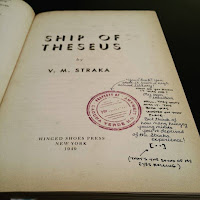Now it’s time for my own little pet project – my love of collecting
works of ergodic literature. Some people also call them illuminated novels. In
a simplified manner, that means the text is accompanied by pictures or other
added marginalia that represent or replace a certain part of the narrative. The
most often quoted examples are Marisha Pessl’s Night Film, Brian Selznick’s The
Invention of Hugo Cabret, and even Mark Z. Danielewski’s House of Leaves. I actually prefer the
term ergodic literature to illuminated novels in these instances, definitely in
the case of House of Leaves.
 |
| House of Leaves |
This term isn’t very widely used in the mainstream bookish media, eg
Book Riot, most book blogs, or BookTube. Perhaps it’s academically too specific
to be of any interest to anyone. However, the books that belong to this genre
are definitely becoming extremely popular. So, even if you don’t know the name
for the genre, you’ll recognise the books that belong to it after just a couple
of initial characteristics. In brief, ergodic literature – as defined in Espen
Aarseth’s Cybertext: Perspectives on
Ergodic Literature – means that the reader has to put in “non-trivial”
effort to consume the text (p1-2). The word itself comes from the Greek words ergon and hodos, which mean “work” and “path”, respectively (ibid). Thus, the
reader has to find their own meandering way through the narrative, but on a
higher level than the regular movement of eyes and turning of pages. In most
cases, the exact order in which to read the text is not indicated. So, ergodic
literature means that a text has an added dimension (eg footnotes, pictures,
text written in a different way, newpaper cutouts, clickable links in ebooks),
and it is up to the reader which part to read first or not at all (many people
skip the footnotes in Susanna Clarke’s Jonathan
Strange and Mr Norrell).
 |
| S. (the book has been made to look like an old library copy) |
Now that the more academic part of the post is over, I think it’s a good
idea to have examples. This isn’t an overly detailed post, but I thought you’d
enjoy learning a new name to a genre of books you already know, and perhaps
enjoy. A great example of a novel where the path of reading is not determined,
is JJ Abrams’ and Doug Dorst’s S. The
novel consists of a main narrative – a fictional book – and then added
marginalia of two people’s conversation about the book and the fictional author
of it. This is as Meta as it gets, people! There are added extras, too: actual scribbled
upon napkins, postcards, slips of paper! It is the reader’s choice
whether to read the in-text novel and margin notes consecutively, or first
finish off the novel, and then reread the margin notes.
 |
| Note: that little bird picture can be scanned via an app for extra content! (Night Film) |
Another interesting aspect of ergodic literature is that it is not
defined by the type of media – it doesn’t have to be a print book. Ergodic
literature refers to the reading experience and so an ebook or any other
electronic medium can also be categorised as such. So here the ebook version of
Night Film with its clickable links is the same as the print book of House of Leaves with disjointed
footnotes and mismatched font size extravaganza.
I have probably rattled on long enough about the definition and sure,
you could just use the term illuminated texts. However, I prefer ergodic
literature if only for the fact that it accurately shows how the same book
could really be different for anyone. Yes, yes, you can say that about every
book – two people might not see the same themes in a work or art – but the
mixture of pictures, footnotes, regular and upside down text implies another layer of the reading experience.
Perhaps some examples, if you too think you’d love this interactive
experience? The most famous one right now – in addition to the abovementioned –
is Illuminae by Amie Kaufman and Jay
Kristoff, a novel made out of documents, interviews and chat transcripts. City on Fire by Garth Risk Hallberg was
published in 2015 and includes document clippings as well. Dawn Kurtagich’s The Dead House also came out last year
and it is once again told in newspaper clippings, diary excerpts and the like.
Zachary Thomas Dodson’s Bats of the
Republic: An Illuminated Novel (again from 2015) and could be seen as
belonging to this genre, as the name suggests. A new one just about to be
released is Sylvain Neuvel’s Sleeping
Giants (note: next week you can read Coll’s review on that). So you see how
these novels are cropping up more lately. Of course, books like these have been
around for a long time now, but it’s great to see them getting more and more
love. Any guesses on what’s behind this new-found love of intricate, multimedia
print books? Maybe our attention spans have become too short to just consume a
“good old” print book with the text running from left to right (or right to
left, depending on where you are), so we need every book to be made into a
videogame-like experience or a Choose Your Own Adventure novel? I’m not sure
what the theory is behind this new publishing phenomenon, but I for one am
definitely enjoying it, and plan to collect a fair few of these books.
What about you? Have you ever thought how these books are called? Do you
even care? Do you need a genre name for books you love? Or do you have any
recommendations that I have most certainly missed?
My list: House of Leaves; S.;
Illuminae; Night Film; Sleeping Giants; The Dead House, A Visit from the Goon
Squad, City on Fire, The Selected Works of T.S. Spivet.
No comments:
Post a Comment